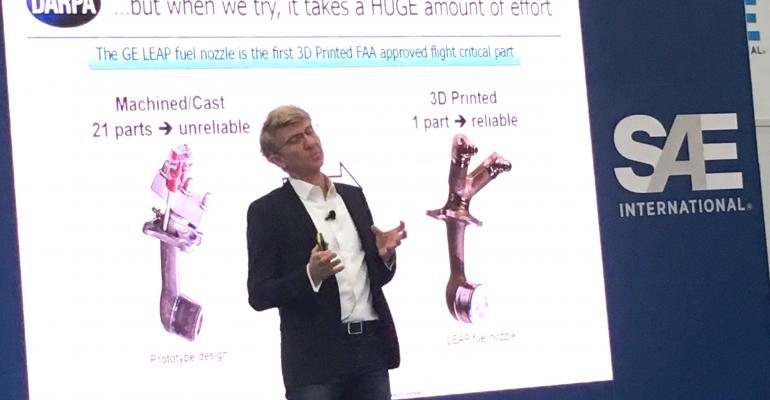DETROIT – Jan Vandenbrande wants to advance design and manufacturing 4,000 years.
Vandenbrande, a program manager for the Defense Advanced Research Projects Agency’s (DARPA) Defense Science Office, is about to launch a program targeted at bringing design and manufacturing up to speed with recent advances in new materials.
It’s a gap that in some ways goes back centuries, he says, pointing to how the structure of wooden ships built 4,000 years ago is reflected in modern aircraft designs.
“Part of (the reason for that) is we’re confident it works,” says Vandenbrande, a former Boeing executive. “(But) the design process and tools (also) haven’t kept up with the advances in materials.”
The DARPA official says modern materials and fabrication techniques, such as composites, additive manufacturing (such as 3D printing) and woven materials allow more complex shapes to be formed and provide more precise control over molecular structures for added strength.
With the right design methodologies, it might be possible to make an airplane out of steel that is as light as one built from aluminum.
But current computer-aided design and engineering tools were created more than 20 years ago with metal machining in mind, he says, and neither the software nor the pure computing capacity available are capable of handling the complexity involved in shaping things in new ways with new materials.
Another problem, Vandenbrande contends, is the human mind, which may have reached the limits of its imagination. He points to an experiment in which students were given full freedom to design a new kind of pencil holder, but ended up creating familiar concepts easily produced with routine materials and manufacturing processes.
To move forward, Vandenbrande believes new mathematics and computational tools will be required to allow people and computers to work together differently. He envisions a future in which humans describe the problem to be solved and computers generate the shape and select the appropriate materials to be used.
The new DARPA team Vandenbrande will head, expected to be announced officially within the next few weeks, will be formed of a wide range of experts, from mathematicians to materials scientists to engineers, he tells a small gathering on the 2016 SAE World Congress exhibition floor Tuesday.
“Expect a wide variety of expertise,” he promises.
Vandenbrande doesn’t offer a timetable for achieving any breakthroughs, but he believes there will be opportunities to advance design and manufacturing methodologies both on the grand scale of an overall vehicle concept, as well as in the design of a single component.
“That’s probably where we’ll start,” he says of the latter.
On its website, DARPA, an offshoot of the U.S. Department of Defense credited in part with creating the Internet, says its Defense Sciences Office is charged with identifying and pursuing high-risk, high-payoff fundamental research initiatives “sometimes reshaping existing fields or creating entirely new disciplines.”
That’s very much what Vandenbrande appears to have in mind.





